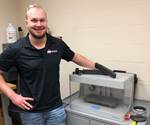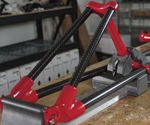Carbon-Filled Thermoplastic 3D Printing Material Replaces Handmade Metal Parts
The material enables 3D printing to produce a part that required replacement three times a month. Reduced labor and faster delivery times are the result.
The intersection of advances in additive manufacturing (AM) and thermoplastic composites technologies—a growing trend touted by industry pros—is nicely exemplified by the recent experience of The Chocolate Factory, Rotterdam, Netherlands. The company runs a network of packaging machines, with its daily throughput relying on the smooth operation of a simple, yet crucial, hook-shaped metal part that lifts wrapped chocolate bars onto a conveyor belt. A problem occurs when the part malfunctions—frequently enough that it necessitates replacement three times a month. Since each replacement part is handmade, delivery can take a month or more.
A solution from Stratasys was recently unveiled when the company announced that Dutch 3D service bureau Visual First is using the company’s FDM Nylon 12 CF carbon-filled thermoplastic—containing 35 percent chopped carbon fiber—to replace those hook-shaped metal parts. The ability to 3D print machinery replacement parts on-demand, in this case using the Stratasys Fortus 450mc Production 3D Printer, has significantly reduced machine downtime, ensuring production line continuity for the company.
According to Visual First’s business owner Carl van de Rijzen, the company can 3D print and deliver production parts to The Chocolate Factory in under a week and its client is impressed with the high stiffness-to-weight ratio of the FDM Nylon 12CF, that result in parts of extreme rigidity. “The material is impossible to bend…the part withstood all tests on the machine and multiple runs were completed without incident. The factory is now enjoying increased production throughput by replacing the metal machine part with our 3D-printed version.”
In follow-up to this success, The Chocolate Factory has now turned to Visual First to solve other design challenges; most notably, to develop a prototype casting mold to test acceptance of its products. Traditionally, this is made from plastic, which is both time consuming and expensive. “With 3D-printed molds created in the Fortus 450mc, the company will be able to further accelerate its production processes,” said van de Rijzen.
Added Nadav Sella, head of Stratasys’ Emerging Solutions Business Unit, “We’re witnessing a growing demand for 3D printed production parts and replacement parts for industrial machinery, especially for packaging machines….These machines require high-level customization due to a large variety of products that are packaged. In many cases, the use of additive manufacturing can not only save time and cost during the manufacture of such machinery, it can also make them more efficient by reducing weight, simplifying the design and increasing functionality.”
This article originally appeared on Plastics Technology’s website.
Related Content
-
3D Printing Molds With Metal Paste: The Mantle Process Explained (Video)
Metal paste is the starting point for a process using 3D printing, CNC shaping and sintering to deliver precise H13 or P20 steel tooling for plastics injection molding. Peter Zelinski talks through the steps of the process in this video filmed with Mantle equipment.
-
Additive Manufacturing Is Subtractive, Too: How CNC Machining Integrates With AM (Includes Video)
For Keselowski Advanced Manufacturing, succeeding with laser powder bed fusion as a production process means developing a machine shop that is responsive to, and moves at the pacing of, metal 3D printing.
-
AM 101: What Is Hot Isostatic Pressing (HIP)? (Includes Video)
Hot isostatic pressing has long been used for metal castings, but is now being applied as a valuable method for closing porosity in metal 3D printed parts.












